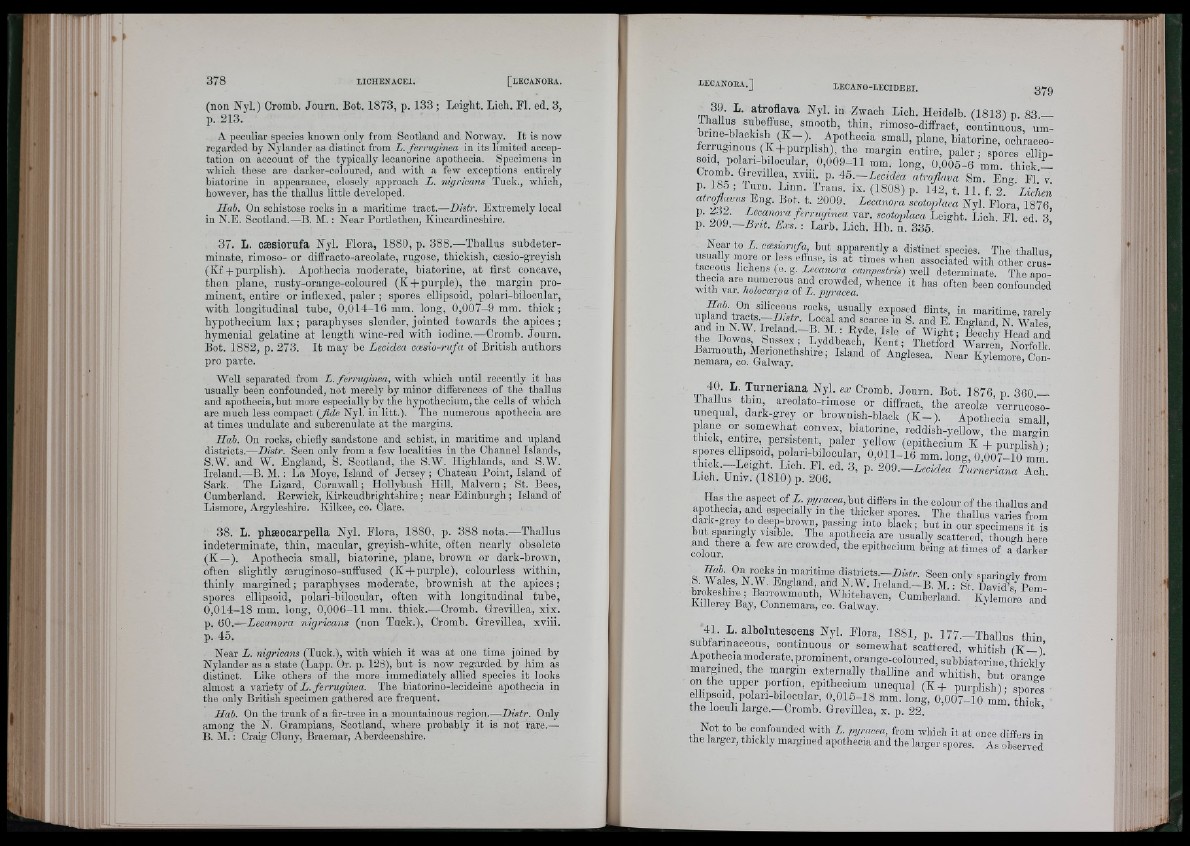
(non Nyl.) Cromb. Jo u rn . Bot. 1873, p. 133 ; Leigbt. Licb. PI. ed. 3,
p. 213.
A peculiar species known only from Scotland and. Norway. I t is now
regarded by Nylander as distinct from L. ferruginea in its limited acceptation
on accoiuit of the typically lecanorine apothecia. Specimens in
which these are darker-coloured, aud with a few e.xceptions entirely
biatorine iu appearauce, closely approach L. nigricans Tuck., which,
however, has the thallus little developed.
Ilab. On schistose rocks iu a maritime tract.—Distr. Extremely local
in N.E. Scotland.—B. M. : Near Portlethen, Kincardineshire.
37. L. cæsiorufa Nyl. Flora, 1880, p. 388.—Thallus siibdeter-
minate, rimoso- or diffracto-areolate, rugose, thiokish, cæsio-greyish
(Kf 4 purplish). Apotheoia moderate, biatorine, at first concave,
th en plane, rusty-orange-ooloured (K + purple), th e margin prominent,
entire or inflexed, paler ; spores ellipsoid, polari-bilocular,
with longitudinal tube, 0 ,0 1 4 -1 0 mm. long, 0 ,0 0 7 -9 mm. th io k ;
hypothecium la x ; paraphyses slender, jo in ted towards th e apices;
hymenial gelatine at length wine-red with iodine.—Cromb. Jouru.
Bot. 1882, p. 273. I t may be Lecidea ccesio-rufa of British authors
pro parte.
Well separated from L. ferruginea, witli -which until recently it lias
usuaUy been confounded, not merely by minor differences of the thallus
and apothecia, but more especially by the hypothecium, the cells of which
are much less compact (Jide Nyl. in litt.). The numerous apothecia are
at tiines uudulate and suborenulate at the margins.
Hab. On rocks, chiefly sandstone and schist, in maritime and upland
districts.—Distr. Seen only from a few localities in the Chanuel Islands,
S.W. and W. Eugland, S. Scotland, the S.W. Highlands, and S.W.
Ireland.—B. M. : La Moye, Island of Jersey ; Chateau Point, Island of
Sark. The Lizard, Cornwall ; Hollybush Hill, Malvern ; St. Bees,
Cumberland. Rerwick, Kirkcudbriglitshire ; near Edinburgh ; Island of
Lismore, Argyleshire. Kilkee, co. Clare.
38. L. ph.æocarpella Nyl. Flora, 1880, p. 388 nota.—ïh a llu s
indeterminate, th in , macular, greyish-white, often nearly obsolete
(K —). Apotheoia small, biatorine, plane, brown or dark-brown,
often slightly æruginoso-suffused (K + purple), colourless within,
th in ly margined; paraphyses moderate, brownish a t th e apices;
spores ellipsoid, polari-bilooular, often w ith longitudinal tu b e ,
0 ,0 1 4 -1 8 mm. long, 0 ,0 0 6 -1 1 mm. thiok.—Cromb. Grevillea, xix .
p. 60.— Lecanora nigricans (non Tuck.), Cromb. Grevillea, xviii.
p. 45.
Near L. nigricans (Tuck.), with which it was at one time joined by
Nylander as a state (Lapp. Or. p. 128), hut is now regarded hy him as
distinct. Like others ot the more immediately allied species it looks
almost a xaxietj of L. ferruginea. The biatorino-lecideine apothecia in
the only British specimen gathered are frequent.
Hab. On the trunk of a fir-tree in a mountainous region.—Distr. Only
among the N. Grampians, Scotland, where probably it is not rare.—
B. M. ; Craig Cluny, Braemar, Aberdeenshire.
rrX n ' i" Zwach Lich. Heidelb. (1813) p. 83 —
Ih a llu s subeffuse, smooth, th in , rimoso-diffract, continuoX, um-
W ,® plane, biatorine, ochraceoferru„
mous (K + p u rp lish ), the margin entire, p a le r; spores ellipsoid,
polari-bilocular, 0,0 0 9 -1 1 mm. long, 0 ,0 0 5 -0 mm. thick —
Cromb. Grevillea, xvui. p. 4 5 .~ L e c id ea atroflava Sm. E n g F l v
p 1 8 5 ; lu r n . Linn. Traus. ix. (1808) p. 142, t. 1 1 . f. 2. Lichen
at,o fla im sE o g . BoL t. 2009. Lecanora scotoplaca Nyl. Flora, 1876,
tn a ' Lecanora ferruginea var. scotoplaca Leight. Lioh. F l. ed. 3,
p. 2 0 J .—B r it. Exs. : Larb. Lich. Hb. n. 335.
Near to L. cæsiorufa, but apparently a dis'tinct species. The thallus
usually more or le..s effuse, is at timesFvhen a s s o e iaV X th oth®“ -’
taceoLis lichens (e. g. Lexanora cmnpestris) well determinate. The apowitb
f r ero^ded, whence it has \Mtn ^ai. holocarpa of L. pyracea. often been con fo u n id
Hab. On siliceous rocks, usually exposed flints, in maritime rarelv
upland tracts.—Disfr. Local and scarce in S. and E. En»land N M'ales
a n dm N .W .I r e la n d .-B .M .: Ryde, Isle of W ight; B e e eh flle ad and
the Downs Sussex; Lyddbeach, Ken t; Thetford -Warren, Norfolk
gX X '"®“
r r i X Nyl. ex Cromb. Jo u rn . Bot. 1876 p 360 —
Ih a llu s th in areolato-rimose or diffract, the areolæ verruco'so-
unequal, dark-grey or browuish-black ( K - ) . Apotbecia small,
plane or somewhat convex, biatorine, roddish-yellow, the margin
thick, entire, persistent, pa le r yellow (epitbecium K + purplish)-
spores ellipsoid, polari-bilocular, 0 ,0 1 1 -1 6 mm. long, 0,O oLlO mm!
daik-grey to deep-bro-ivn, passing into black ; but iu our specimens it is
hut sparingly visible. The apotheoia are usually scattered, though here
coloui ® crov ded, the epithecium being at tiines of a darker
41. L. a lb o lu te s c en s Nyl. Flora, 18S1, p. 1 7 7 .-T h a llu s thin
subfarinaceous, continuous or somewhat scattered, whitish f K - l ’
Apotheoiamoderate,prominent, orange-coloured, subbiatorine, Ihicklv
m a rp n e d , th e margin externally thalline and whitish, bn t orange
on th e upper portion epithecium unequal (K + p u rp lish ); spores
ellipsoid polan-bilocular, 0 ,0 1 6 -1 8 mm. long, 0 ,0 0 7 -1 0 mm thick
the loculi large.—Cromb. Grevillea, x. p. 22. ’
Not to be confounded with L. pyracea, from which it at once differs in
the largei, thickly margined apothecia and the larger spores. As observed